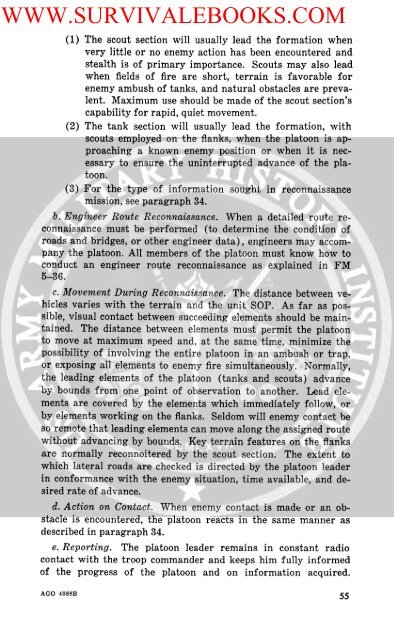FM 17-35 ( Armored Cavalry Platoon, Troop and Squadron ) 1960
FM 17-35 ( Armored Cavalry Platoon, Troop and Squadron ) 1960
FM 17-35 ( Armored Cavalry Platoon, Troop and Squadron ) 1960
Create successful ePaper yourself
Turn your PDF publications into a flip-book with our unique Google optimized e-Paper software.
WWW.SURVIVALEBOOKS.COM<br />
(1) The scout section will usually lead the formation when<br />
very little or no enemy action has been encountered <strong>and</strong><br />
stealth is of primary importance. Scouts may also lead<br />
when fields of fire are short, terrain is favorable for<br />
enemy ambush of tanks, <strong>and</strong> natural obstacles are prevalent.<br />
Maximum use should be made of the scout section's<br />
capability for rapid, quiet movement.<br />
(2) The tank section will usually lead the formation, with<br />
scouts employed on the flanks, when the platoon is approaching<br />
a known enemy position or when it is necessary<br />
to ensure the uninterrupted advance of the platoon.<br />
(3) For the type of information sought in reconnaissance<br />
mission, see paragraph 34.<br />
b. Engineer Route Reconnaissance. When a detailed route reconnaissance<br />
must be performed (to determine the condition of<br />
roads <strong>and</strong> bridges, or other engineer data), engineers may accompany<br />
the platoon. All members of the platoon must know how to<br />
conduct an engineer route reconnaissance as explained in <strong>FM</strong><br />
5-36.<br />
c. Movement During Reconnaissance. The distance between vehicles<br />
varies with the terrain <strong>and</strong> the unit SOP. As far as possible,<br />
visual contact between succeeding elements should be maintained.<br />
The distance between elements must permit the platoon<br />
to move at maximum speed <strong>and</strong>, at the same time, minimize the<br />
possibility of involving the entire platoon in an ambush or trap,<br />
or exposing all elements to enemy fire simultaneously. Normally,<br />
the leading elements of the platoon (tanks <strong>and</strong> scouts) advance<br />
by bounds from one point of observation to another. Lead elements<br />
are covered by the elements which immediately follow, or<br />
by elements working on the flanks. Seldom will enemy contact be<br />
so remote that leading elements can move along the assigned route<br />
without advancing by bounds. Key terrain features on the flanks<br />
are normally reconnoitered by the scout section. The extent to<br />
which lateral roads are checked is directed by the platoon leader<br />
in conformance with the enemy situation, time available, <strong>and</strong> desired<br />
rate of advance.<br />
d. Action on Contact. When enemy contact is made or an obstacle<br />
is encountered, the platoon reacts in the same manner as<br />
described in paragraph 34.<br />
e. Reporting. The platoon leader remains in constant radio<br />
contact with the troop comm<strong>and</strong>er <strong>and</strong> keeps him fully informed<br />
of the progress of the platoon <strong>and</strong> on information acquired.<br />
AGO 4088B 55

















